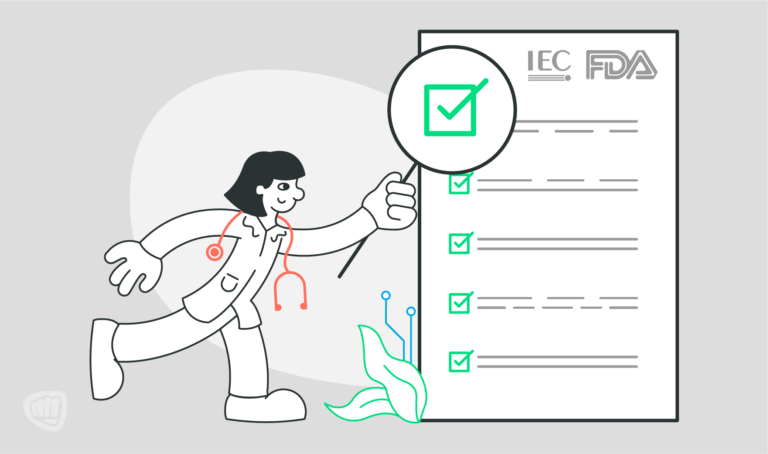Introduction
Testing isn’t the question; knowing when it matters most is. This is especially true in connected systems, where missing the proper test at the right time doesn’t just slow you down and creates a risk that’s harder to fix later.
This article introduces the different types of testing for embedded medical software, how device classification plays a role, and why early decisions matter. The goal is to equip you with the foundational understanding to ask the right questions and make smarter decisions so you can choose the right testing strategy for your project.
Looking to build or revise your embedded medical device testing strategy? Check out Building a Risk-Aligned Testing Strategy for Your Embedded Medical Device. It walks through how to align your plan with your device’s real-world risk profile.
Start Early or Pay Later
We’ve worked with product teams building Class II and III connected medical devices, often under tight deadlines and with high stakes. What we’ve seen repeatedly is that the earlier testing is considered in the development process, the fewer delays, failures, and compliance headaches arise later.
Testing isn’t just a verification step. It’s fundamental to proving that your device performs safely and reliably under all foreseeable conditions. This is especially true when it operates in complex environments, interacts with external systems, or updates in the field.
Delaying key testing decisions can create blind spots that ripple throughout development:
- System-level issues caught too late
- Rework that derails timelines
- Incomplete documentation for regulatory submissions
- And worst of all, preventable safety risks
A proactive testing strategy built into the architecture, not bolted on at the end, is one of the most effective ways to reduce risk and increase development efficiency. When it’s done well, testing moves from being a compliance burden to a strategic asset.
Testing Isn’t One-Size-Fits-All
Most teams understand that testing is essential, but deciding how to apply it effectively isn’t always straightforward. Regulatory bodies like the FDA and IEC 62304 provide classifications that define baseline expectations, but they don’t dictate how deeply to test or where to focus your effort.
Each testing method—unit testing, integration testing, and hardware-in-the-loop simulations—has a specific purpose. What matters is aligning those methods to your system’s actual behavior, complexity, and risk exposure.
Without that alignment, it’s easy to spend time testing the wrong things too deeply or miss a critical failure point altogether. The right strategy starts with how your device works and not just how it’s classified.
When Connectivity Complicates Testing
For standalone devices, testing often focuses on internal logic and component interaction. But once your device connects, whether via BLE, Wi-Fi, or cloud APIs, the definition of “working correctly” shifts.
Now, timing, data flow, and protocol behavior matter just as much as software correctness. You’re not just testing whether code runs, you’re testing whether systems coordinate. And in many connected systems, failure isn’t a crash, it’s a silent sync issue, a stale reading, or a delayed therapy action.
These are real risks and the earlier you factor them into your testing strategy, the better prepared you’ll be to catch them before they reach patients.
How Classification Shapes (But Doesn’t Define) Your Test Plan
Medical device software is classified under IEC 62304 based on the level of risk it presents to patient safety:
- Class A: No injury or damage to health
- Class B: Non-serious injury possible
- Class C: Death or serious injury possible
These classifications help define your baseline testing obligations but don’t tell the whole story, especially for connected medical devices. When your device communicates with other systems, transfers patient data, or receives updates in the field, you’re no longer just dealing with software in isolation. You’re managing a live, evolving ecosystem.
The best teams start with classification and then layer in product complexity, integration points, and real-world behavior to guide their testing strategy.
Types of Embedded Testing (and When to Use Them)
Each testing method plays a distinct role depending on what you’re validating, when you’re validating it, and what’s at stake. Here are the most common types of testing:
- Static Analysis
We see teams overuse unit testing in isolation, only to find real issues emerge when components start talking to each other. Use it to bulletproof critical logic, but don’t let it become a false sense of security. - Unit Testing
Best used for critical logic, real-time data handling, or components with complex states. It verifies that individual pieces work as expected, in isolation. Unit testing is often overused or underprioritized, so context matters. - Integration Testing
In integration, silent failures hide, especially in BLE or mobile/cloud interfaces. We’ve seen entire product delays tied to mismatched expectations between modules that all passed their unit tests. - Hardware-in-the-Loop (HIL)
HIL catches the bugs you can’t script or mock, power cycles, sensor drift, and BLE drops under interference. It’s an effort to set up, but it pays for itself the first time you avoid a late-stage panic. - Security Testing
Too often left until the end. We’ve seen connected devices pass V&V with functional software and quietly fail under spoofed or malformed packets in the field. If it talks to anything, test it like someone’s trying to break it.
Skipping any of these can create blind spots that are hard to recover from later.
Why Safety Is the Guiding Principle
Safety is the reason testing exists. A device malfunctioning in the field can have serious consequences, both for patients and the teams responsible for delivering a safe product. That’s why high-performing teams don’t just aim to “meet requirements.” They treat safety as a design input, using testing to validate assumptions and surface edge-case risks before they become real problems.
The Therac-25: In the 1980s, a software race condition in the Therac-25 radiation therapy machine led to massive radiation overdoses in patients. The issue was traced back to inadequate testing, poor system integration, and insufficient safeguards around user interaction. Multiple injuries and deaths followed. The lesson wasn’t just about bugs—it was about the cost of underestimating system-level risks and the need for robust validation strategies from the start.
Modern development tools and regulatory frameworks have come a long way since then, but the takeaway remains the same: you can’t validate safety after the fact. A risk-aware testing strategy helps uncover what can go wrong and how those failures manifest when real people are involved.
Why Security Testing Is Non-Negotiable for Connected Devices
In connected medical systems, safety and security are inseparable. Any device that stores or transmits patient data or interacts with external systems must be validated for functionality and resilience against tampering, data leaks, and malicious interference.
Security failures don’t always show up as obvious bugs. They can be silent breaches or subtle behavior changes triggered by spoofed data or unauthorized access. In safety-critical contexts, this can be catastrophic.
Take an automatic insulin pump, for example. If a third party can forge or replay communication to alter dosing instructions, the consequences aren’t just about privacy but patient harm. That’s why transport-level validation, encryption enforcement, and input fuzzing aren’t optional. They’re essential.
Security testing isn’t a box to check at the end of development. It’s a process that evolves with the system and the threats it faces in the field.
Making Smart Testing Decisions
The best strategies aren’t built around test volume. They’re built around where things break and how badly they break when they do. If your plan doesn’t reflect how your system fails in the real world, it’s not just inefficient—it’s risky.
That means aligning decisions to how your system could fail in the real world, not just how it’s classified on paper. If you’re unsure whether your current approach does that or whether risk exposure has shifted as your product evolved, now is the time to re-evaluate. The right call early can save you from late-stage surprises, audit issues, or, worse, a device that doesn’t perform when it counts.




